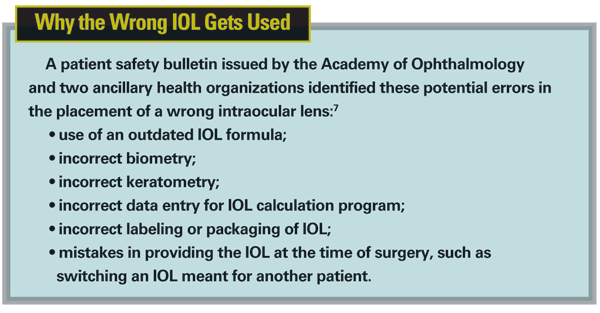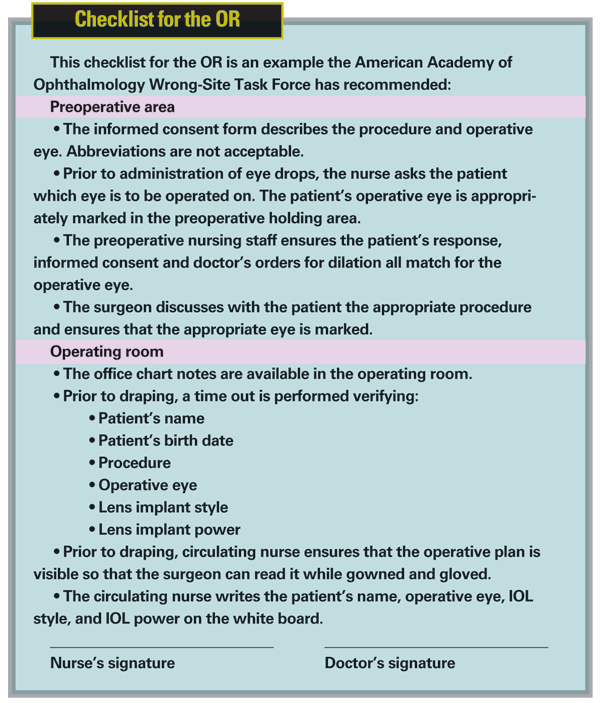It should have been a routine procedure. A 75-year-old woman had an intraocular lens implanted for a cataract. If this case had followed the script of the vast majority, she would have returned for one postoperative follow-up visit, and then gone on her way to rave about her newfound vision.1
Unfortunately, the posterior lens decentered. The surgeon readjusted it, but the lens decentered again. The surgeon did not remove the lens, but placed a second anterior lens. Later, a second ophthalmologist removed both lenses and diagnosed the patient with macular edema and vision loss.
The patient sued the first ophthalmologist, claiming that he placed the wrong lens and then failed to refer her to a specialist, resulting in the loss of vision. The doctor's defense team invoked a familiar argument: The result was a known complication of the operation. Fortunately in this doctor's case, the court agreed and ruled in his favor. However, that did not save him the anguish and distraction of defending a lawsuit.
"Once you've been sued, you've lost no matter what the outcome because you're going through the misery, the heartache, the time, the cost of trying to defend yourself," says Richard L. Abbott, MD, chair of the department of ophthalmology at the University of California, San Francisco, and chairman of the board of the Ophthalmic Mutual Insurance Company, which writes malpractice policies for ophthalmologists.

Ophthalmology thought leaders and malpractice defense attorneys say protocols and checklists, good informed consent, attentiveness to patients' complaints and diligent documentation of your care can spare you the misery of a malpractice claim, or at least provide a credible defense if that claim goes forward.
Why Ophthalmologists Get Sued
The Physician Insurers Association of America reports 6,703 malpractice claims were pending against ophthalmologists from 1985 to 2007. That's about one claim for every three ophthalmologists, an average of about 304 a year. One in four claims resulted in a payment.
Today, the trend is toward fewer claims against ophthalmologists. In 2007, about 5 percent of ophthalmologists OMIC insured reported a claim, down from about 9 percent in 2003.2
Because ophthalmologists perform more cataract surgery than any other surgical procedure, it is the leading source of malpractice complaints. Typically, the IOL is the culprit—either the wrong IOL, wrong power or wrong measure. OMIC data showed the wrong IOL alone accounted for more than half of the "wrong" cases it observed from 1987-2008. John Simon, MD, chairman of ophthalmology at
In 2007, cataract operations accounted for about 22 percent of all OMIC claims. Problems after either exam or evaluation (14 percent) and LASIK (12 percent) followed.2

"Mistakes are extremely uncommon when it comes to wrong site or wrong IOL implant, but they are serious," says Joseph Caprioli, MD, FACS, chairman of the
Preop Communication
The best defense against surgical malpractice actually starts with patient screening and matching the operation to the patient. Thomas J. Donnelly, JD, a malpractice defense specialist in
The ophthalmologic cases his firm has handled commonly involve patient selection. "You can imagine the importance of chart notes if the patient claims in retrospect, 'I never should have had this recommended to me,' or, 'I wasn't advised of the potential complications,' " Mr. Donnelly says.
Clear verbal communication and concise and timely documentation are keys to building patient rapport. A study of obstetrics and gynecology patients at the
The study authors, a psychologist and a psychiatrist, even identified these seven qualities physicians displayed that helped build patient rapport:
• friendliness;
• personal interest in the patient;
• emotionally supportive of the patient;
• clear communication;
• let the patient know what to expect;
• confirmed the patient understood, and
• offered the patient suggestions.
Mr. Donnelly concurs with these findings. "I have seen peer-reviewed medical literature that establishes a number of lawsuits are filed by patients or their families because they think it's the only way to get an answer or explanation as to what happened for a complication," he says.
Dr. Abbott has advocated a systematic preoperative assessment that addresses the reason to operate, informed consent, instructions for preoperative medications and postoperative care schedule. "This needs to address postoperative care, comanagement—if the doctor is going to provide all the postoperative care, if another physician or physician extender such as an optometrist is going to do it—and when it's going to be done," he says.
The Nuances of Informed Consent
The Joint Commission on Accreditation of Healthcare Organizations identified a failure in informed consent as a common event in wrong-site surgery: specifically, that patients did not participate in identifying the surgical site.5

Quality informed consent helps in shaping a patient's expectations preoperatively, but even this process needs validation. "From a litigation perspective, there's no way to prevent a lawsuit from an occasional patient who has been informed of complications but he says he wasn't told," says James M. Goodman, JD, a malpractice defense attorney in
The surgeon should participate in the informed consent before the day of surgery. Says Dr. Abbott: "What many doctors do in busy surgical practices is, they use videos or staff to help with informed consent, but at some point the doctor preoperatively, and not just on the day of surgery but prior to that, needs to be involved in the process."
Says James Nelson, JD, a partner with Mr. Donnelly: "The setting for informed consent should be an exam room or a hospital room, and not a waiting room, a nursing station counter, or a gurney in the OR holding area." Family and friends, he adds, "shouldn't play any more than a peripheral role" in the process.
Documentation of the informed consent discussion is critical, but it need not be onerous. Dr. Abbott, who's lectured on documentation, recommends keeping a checklist of the usual informed-consent talking points. "In the medical record the physician just writes a note: 'Had the usual detailed discussion with patient regarding risks, complication, alternatives and benefit of procedures.' " Date the checklist and keep it in the patient record. The checklist can be annotated for non-routine events such as implantation of a multifocal IOL.
Advertising and marketing can also factor into shaping patient expectations. "If advertising makes a claim, 'Every one of my patients sees 20/20 a year after cataract surgery,' and somebody doesn't, it's misleading," Dr. Abbott says.
Having the patient sign a simply worded consent form, as is common for LASIK, usually suffices. Samples of informed consent documents are available on the OMIC Web site (omic.com).
Typically, informed consent cases "are not particularly strong with juries," Mr. Goodman says, especially if the physician was diligent in documentation.
The need for verifiable documentation carries throughout the perioperative period. For plaintiff's attorneys, descriptive chart notes can make or break a malpractice claim.
In chart notes, timeliness is of the essence. "The notes made well after the fact once the patient's complication is known are inherently suspicious," Mr. Donnelly says. "The trustworthiness of any note, if it's not done in a timely fashion, makes the doctor look sloppy or too busy; or if it's made once a complication is known, it's characterized as entirely self-serving."
Preventing Errors in the OR
A host of strategies exist to prevent surgical errors. In 1997, Dean Brick, MD, then chair of OMIC's risk management committee, outlined these six steps for cataract surgery that Paul Weber, JD, vice president of risk management at OMIC, still finds relevant today:2
1. Employ one or two technicians well-trained in keratometry and biometry.
2. Review the scans and keratometry data when choosing the IOL.
3. Be well-versed in the IOLs you use.
4. Use an updated formula for selecting the IOL.
5. Post a list of IOL choices for that day's patients on the side of the phaco machine and check it before each insertion, and call a "time out" before the operation.
6. Use a preoperative checklist to document data, informed consent and any preoperative and postoperative instructions given to the patient.
The time out just before anesthesia should involve these steps: The surgeon asks the patient and surgical team to verify the correct patient and IOL; review the chart in the OR; and make a mark next to the operative eye.
The Joint Commission has updated its Universal Protocol for office-based surgery,6 and it has been widely accepted by ophthalmologists. In his study of 106 surgical errors last year, Dr. Simon concluded the Universal Protocol would have prevented 85 percent of them.3
Beyond the Universal Protocol, best practices have taken a cue from aviation and aeronautics to embrace the use of an OR checklist. "A checklist is a real good idea," Dr. Simon says. "When you get on an airplane, the pilot does a checklist before takeoff—you count on him to do that." The American
Handling Postoperative Problems
When an error does occur, how you handle it postoperatively can alter the patient's attitude about pursuing a malpractice claim. In a general surgery case Mr. Donnelly is defending, a patient's family called the surgeon's cell phone at least four times about problems. That he gave out his cell phone number works in his favor; that he failed to make notes about the calls does not. "This case isn't going to come down to medicine," he says. "It's going to come down to credibility: What was the surgeon told, and how many phone calls were made?"
Dr. Abbott advocates a system for documenting postoperative calls. His protocol lists specific symptoms and what action staff should take for each one.
Maintaining patient rapport is also important postoperatively. "If you have any questions about what's going on with the patient, you're much better off having the patient seen in the office than waiting a few days, particularly with a lens implant that can become dislodged," Mr. Goodman says. "Even if there's no intervention, the patient will more readily accept a complication as a complication if he has a good rapport with the physician."
Again, documentation plays a role. "It doesn't necessarily take a three-paragraph note, but from an ophthalmology standpoint the physician should document what he's actually done," Mr. Goodman says.
Having that patient come to your office, and then documenting that in a timely, concise fashion is better than having him or her go to a lawyer's office.
1. Woman claims posterior lens was improper for use in cataract surgery — three procedures required, and anterior lens ultimately placed — loss of vision in eye. Laska L, ed. Medical Malpractice Verdicts, Settlements and Experts.
2. Weber P. Wrong eye, wrong IOL, wrong patient. Ophthalmic Mutual Insurance Company Ophthalmic Risk Management Digest 2008;18:1-5.
3. Simon JW, Ngo Y, Khan S, Strogatz D. Surgical confusions in ophthalmology. Arch Ophthalmol 2007;125:1515-1522.
4.
5. Joint Commission on Accreditation of Healthcare Organizations: Sentinel Alert Event Issue Six, August 28, 1998. Available at: http://www.jointcommission.org/SentinelEvents/SentinelEventAlert/sea_6.htm. Accessed Dec. 5, 2008.
6. Joint Commission on Accreditation of Healthcare Organizations: Universal Protocol for office-based surgery. Available at: http://www.jointcommission.org/NR/rdonlyres/554D1FCA-D14D-4804-9136-F1D384F4EAE7/0/UP_OBS_20080616.pdf. Accessed Dec. 5, 2008
7. Minimizing Wrong IOL Placement. Patient Safety Bulletin Number 2: A joint statement of the American Academy of Ophthalmology, the American Society of Ophthalmic Registered Nurses and the American Association of Eye and Ear Hospitals. Available at: http://webeye.ophth.uiowa.edu/asorn/Safety/SafetyBulletin2.htm. Accessed December 3, 2008.
8. Joint Commission on Accreditation of Healthcare Organizations. Tips for patients to prevent wrong site surgery. Available at: http://www.jointcommission.org/PatientSafety/UniversalProtocol/wss_tips.htm. Accessed Dec. 5, 2008





